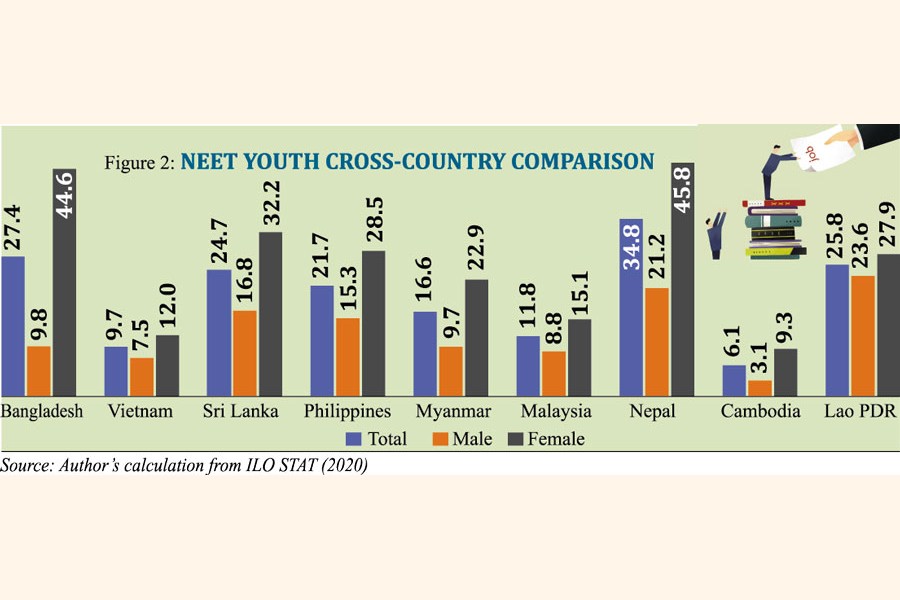
The triangular epitome of employment challenges in Bangladesh's labour market
Mohammad Nazmul Avi Hossain | Wednesday, 23 November 2022

 Bangladesh progressed impressively during its 50 years' journey after independence in terms of social and economic development. Bangladesh's average per capita GDP growth rate has been over 5 per cent for the last four decades, which is impressive compared to its neighbouring countries and many other developing countries.
Bangladesh progressed impressively during its 50 years' journey after independence in terms of social and economic development. Bangladesh's average per capita GDP growth rate has been over 5 per cent for the last four decades, which is impressive compared to its neighbouring countries and many other developing countries.
In meeting the UN criteria, Bangladesh expects to graduate from the Least Developed Country (LDC) category in 2026. Macroeconomic policies in recent years have successfully kept inflation stable, the debt to GDP ratio low, and external buffers adequate. IMF (2022) says the country's growth is expected to pick up to 6.6 per cent in FY22, supported by a robust rebound in exports, continued implementation of the stimulus packages, and reconciling monetary and fiscal policies. The government has set a target of a 7.5 per cent GDP growth rate for the country in the fiscal year 2022-23. Bangladesh's real GDP growth rate had seen an upward trend till FY2019 at 8.2 per cent but fell to 3.5 per cent in FY2020. The 7FYP set the target of an 8% real GDP growth rate by FY20, which was fulfilled in 2019, but due to the pandemic, it could not be sustained.
The COVID-19 pandemic brought several challenges and pushed major macroeconomic confounders into fragility. Jobs were lost permanently and temporarily, enterprises were shut down, and working hours were reduced due to social distancing initiatives, resulting in a reduced aggregate demand that negatively affected economic growth.  When the country was recovering from the COVID-19 crisis socially and economically, the Ukraine-Russia war intensified the global economic crisis, leading towards an anticipated economic recession.
When the country was recovering from the COVID-19 crisis socially and economically, the Ukraine-Russia war intensified the global economic crisis, leading towards an anticipated economic recession.
The 8th FYP provided a medium-term development strategy at a time when Bangladesh is looking to promote a strong recovery from the COVID-19 pandemic and build on its economic growth, and put the country on track to achieve the SDGs through integrated and innovative financing approaches, achieving Middle Income Country Status; graduation from LDC status by 2026; and elimination of extreme poverty by 2030/31.
The national plan lays out a long-term, pro-poor, and inclusive growth strategy that promotes labour-intensive, export-oriented manufacturing-led growth and agricultural diversification; promotes gender balance in the workforce; invigorates micro and small enterprises; develops a more modern services sector while expanding export of non-factor services; and increases overseas employment.
The ambition of the government of Bangladesh is to create almost 9.5 million jobs in total, both in the domestic and foreign labour markets. Bangladesh Vision 2041 set the overarching national goals and approach for development, aspiring to be a country free of poverty where economic and social justice prevails.
In this article, I will emphasise three major labour market indicators in analysing Bangladesh's major challenges on the employment front. They are i) Employment to Population Ratio, ii) Youth NEET, and iii) Share of vulnerable employment in the economy.
According to the ILO's definition, the employment-to-population ratio is the proportion of a country's employed population. The employment-to-population ratio indicates how efficiently an economy provides jobs for people who want to work. A high ratio means that a large proportion of the population is employed. Whereas a lower employment-to-population ratio can be seen as a positive sign, especially for young people, if an increase in their education causes it. Figure one reflects that for the last three decades, the employment-to-population ratio of the working-age population of Bangladesh has been around 56-57 per cent.
This is perhaps alarming as the demographic dividend this country has been enjoying for the last 3-2 decades is on the trajectory of getting into a trap of untapped and lost opportunity. Moreover, a high level of youth, 28 per cent of the total youth population, are not in education, employment or training (NEET) in Bangladesh. Suppose the employment-to-population ratio of the country had been low due to the high participation of youth in education or training. In that case, it is highly unlikely to have almost one-third of the total youth of the country in the NEET category.
To take a deep dive into the youth NEET in Bangladesh, we can see a simple cross-country comparison among countries with similar geographic or/and economic profiles, such as Bangladesh. Figure 2 illustrates the cross-country status of youth NEET. According to ILO estimates, the youth unemployment rate is 14.8% in Bangladesh as of 2020, which is almost three times higher than the overall unemployment rate of 5.2%. The share of unemployed youth in total unemployment is 79.6 per cent. More strikingly, the unemployment rate among youth having a tertiary-level education is 13.4 per cent (BBS, 2018). The following figure on Youth NEET reflects the comparative status of some South Asian and South-East Asian countries (2021 ILO STAT). Data show that Bangladesh has the second highest share of youth NEET, followed by Nepal. The share of NEET youth in Vietnam, Cambodia, Malaysia, and Myanmar is either one-third or half of that in Bangladesh or Nepal.
The gravest concern for Bangladesh is the share of female youth in NEET (44.6 per cent), which is more than four times higher than the share of male youth (9.8 per cent) in NEET. If we look carefully, the share of male youth NEET in Bangladesh is like Malaysia, Myanmar and Vietnam. It is evident from the data that the high share of female youth NEET is largely contributing to a high level of the total share of youth NEET in Bangladesh. Therefore, the argument I placed is that Bangladesh's constant employment-to-population ratio is not a good labour market signal if we couple it with the high level of youth NEET, considering that the country has been enjoying a demographic dividend for decades.
Besides the employment-population ratio and youth NEET, another crucial and often ignored labour market indicator to assess employment conditions in Bangladesh is the proportion of people who are in vulnerable employment.
According to ILO, the status in employment distinguishes between two categories of the total employed - (a) wage and salaried workers (also known as employees); and (b) self-employed workers, with the subcategories: (i) self-employed workers with employees (employers), (ii) self-employed workers without employees (own-account workers), and (iii) members of producers' cooperatives and contributing family workers (also known as unpaid family workers). Vulnerable employment refers to the sum of (ii) own-account workers and (iii) contributing family workers.
Vulnerable employment refers to family and own-account workers as a percentage of total employment. Figure 3 depicts the share of vulnerable employment in Bangladesh, which has decreased since 1991. However, still more than a half of the employment in the country is vulnerable, and this becomes a big threat to the economies of scale, resilient growth of businesses and sustainable economic opportunities for creating decent employment scopes for potential new entrants in the labour market.
To increase the employment-to-population ratio and youth labour force participation and reduce the share of vulnerable employment, proactive policies such as job search assistance, apprenticeships, small and medium enterprise support, and industry-led training programmes are low-hanging fruits. For long-lasting impacts, stronger labour market institutions and decent working conditions are a must.
Macroeconomic factors, such as private investment as a share of gross domestic product (GDP), increase formal job creation and social security for unemployed youth. For Bangladesh, women will play a pivotal role in making its national employment policy successful. Bangladesh's three big labour sector agencies are the Ministry of Labour and Employment, the Employers' Federation, and the Workers Union. These bodies must strengthen collaboration and coordination among themselves. Only then will different government agencies, development partners and the private sector be able to solve the policy challenges going forward.
Recently the National Employment Policy (NEP) of Bangladesh has been formulated and officially adopted by the Government of Bangladesh. It is crucial to formulate a comprehensive national action plan to support the NEP and implement it successfully in alignment with the vision of the 8th Five-Year Plan.
Mohammad Nazmul Avi Hossain is a Labour Economist, currently working for the ILO.
nazmulavi@gmail.com
[All the analyses and narratives of this article are the author's personal interpretation and opinions]